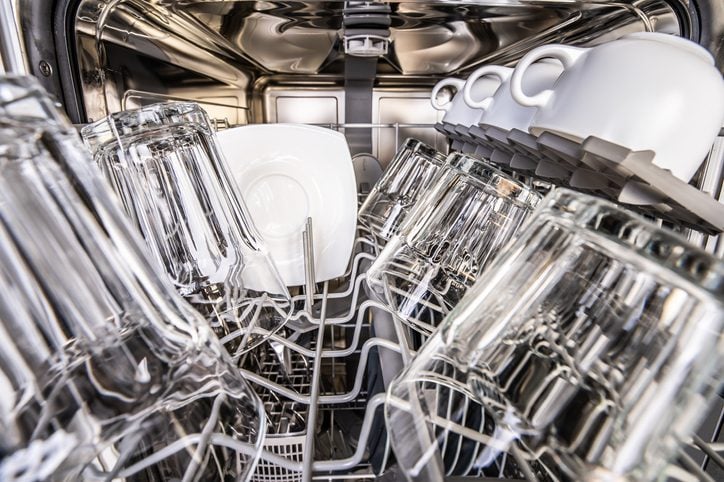For much of my life, I never had a dishwasher. I thought that was a good thing because it felt more sustainable.
I was wrong.
In most instances dishwashers are actually the greener option, especially today’s Energy Star-certified models. They cost far less to run and use exponentially less water than models from a decade ago, all while cleaning dishes better.
If you can swing it financially, adding a newer-model Energy Star dishwasher to your kitchen will boost your home’s green factor. But even if you have an older model, that’s still better than hand-washing in most situations, as long as you use it correctly.
Here are some tips for the greenest and healthiest ways to wash dishes, whether in a dishwasher or by hand.
Dishwashers Are More Cost Effective
Hands down, dishwashers use less water and energy than hand-washing.
Energy Star-rated models average 3.5 gallons of water per cycle, vs. the 10 to 40 gallons of water it takes to do dishes by hand, or the 10-plus gallons older and less-efficient dishwashers consume. That means you save precious water as well as the energy it takes to heat it.
Also, most newer dishwashers heat the water internally, making it the most efficient temperature for energy savings and sterilizing dishes. Save even more by running on eco-mode and letting dishes air dry instead of activating the heated-dry function.
Don’t Rinse Dishes Before Loading
It’s tempting, but don’t do it. All you really need to do is scrape food scraps into your compost bin and let the machine do the rest.
“Most dishwasher detergent is designed to grab onto food debris to work, so it actually isn’t able to do its job as well with perfectly clean dishware,” says Tonya Harris, an environmental toxicity specialist and author of The Slightly Greener Method. “Load it gunky grime and all!”
Rinsing also wastes a lot of water, negating the savings of using a dishwasher.
Fill But Don’t Overload the Dishwasher

It takes the same amount of energy to run a dishwasher no matter how many dishes you load into it, so it makes sustainable sense to only run it when it’s full. But don’t overfill it, says Harris.
A crammed-full dishwasher, where dishes and glasses overlap, means the soap and water can’t reach all the areas, forcing you to re-wash some items.
Use Eco-Friendly Detergent
Many conventional dishwashing liquids and tablets contain harsh chemicals that are harmful to our health and the environment. There’s also growing concern about dissolvable PVA plastics in detergent pods, and the harm these do to our waterways.
For healthier dishwashing, use detergents with a third-party health and environmental certification, like GreenSeal and Environmental Working Group (EWG). And read the labeled ingredients for problematic substances.
“It is important to be weary of greenwashing claims on products such as ‘non-toxic,’ ‘earth-friendly’ and ‘natural,’ ” says Sydney Swanson, a healthy living analyst at EWG. “These terms have no legal basis and are often used as marketing tactics.”
Also, Harris says, “More soap is not always better.” Besides costing more, too much soap leaves a cloudy film on dishes.
Clean the Filter
Many of us (including me, for a long time!) don’t realize dishwashers need their filter cleaned periodically to ensure clean dishes and prolong the life of the pump. A clean filter will also keep food particles from spraying back onto dishes and prevent unpleasant smells between washings.
Most filters are simple to clean; your owner’s manual will tell you how to do it. There are even some models, like this one from Beko, that feature self-cleaning filters.
Don’t Wash Everything
Of course, certain items should never go through the dishwasher. These include wooden cutting boards, bowls and utensils; cast-iron products; fine china and hand-painted items; high-quality knives; thin plastic containers; crystal; insulated mugs; and silver. Make sure to hand-wash those.
Hand-Washing Best Practices
When you do hand-wash dishes, Harris recommends these tips for efficiency and sustainability:
- Wash in a clean sink, reducing the risk of adding bacteria and other germs to the items you’re trying to clean.
- Soak stuck-on messes for 20 to 30 minutes, but don’t soak knives. You’ll risk cutting yourself if you can’t see them in soapy/dirty water.
- Refill the sink with clean, warm water and scrub dishes with a sponge or dish rag.
- Wash dishes from least to most dirty, to keep sponges and the water cleaner longer.
- Air dry items on a rack, except glasses and silverware, which you can dry with a dishcloth to prevent spots.
- Clean the sponge after every use by rinsing it well and placing it in the microwave for one minute. Make sure the sponge is wet when you put it in or it can catch fire. Wait several minutes to take it out so it isn’t too hot to touch. Then let it air dry on a counter. You can also run a sponge through the dishwasher.
Did you miss our previous article...
https://rsssuperfeeds.com/life-hacks/what-to-do-if-your-garage-door-opens-by-itself






